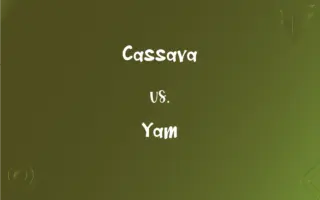Mandrill vs. Drill: What's the Difference?
By Janet White || Updated on November 30, 2023
A mandrill is a large, colorful primate native to African rainforests, while a drill is a similar but less colorful primate also found in African forests.

Key Differences
Mandrills are known for their striking facial colors, with bright red and blue hues on their faces and rumps. Drills, in contrast, have a more subdued appearance, with darker, primarily black and gray coloring and less prominent facial features.
Mandrills are among the largest of the monkey species, with robust bodies and pronounced canine teeth. Drills are slightly smaller and less stocky, with more understated physical features compared to mandrills.
In terms of habitat, mandrills primarily inhabit the rainforests of west-central Africa. Drills are also forest dwellers but are more limited in range, found mostly in Nigeria, Cameroon, and on the island of Bioko.
Socially, mandrills live in larger groups and exhibit complex social structures. Drills, while also social, typically form smaller groups and have a less complex social hierarchy.
Both species face threats from habitat loss and hunting, but drills are considered more endangered due to their limited range and smaller population numbers.
ADVERTISEMENT
Comparison Chart
Facial Coloration
Bright red and blue hues
Darker, predominantly black and gray
Body Size
Larger and more robust
Slightly smaller and less stocky
Habitat
Rainforests of west-central Africa
Forests of Nigeria, Cameroon, and Bioko
Social Structure
Larger groups with complex hierarchy
Smaller groups, less complex social order
Conservation Status
Vulnerable, facing habitat loss and hunting
More endangered due to limited range
ADVERTISEMENT
Mandrill and Drill Definitions
Mandrill
A primate with a unique appearance, including a colorful rump.
The mandrill’s colorful rump is a key identifier.
Drill
A species native to specific African regions, including Bioko.
Drills are rarely seen outside their natural habitats.
Mandrill
One of the largest monkey species, with pronounced canine teeth.
The mandrill used its teeth to crack open nuts.
Drill
A primate closely related to the mandrill, but less colorful.
The drill moved quietly through the underbrush.
Mandrill
A species known for its distinctive red and blue facial markings.
We observed a mandrill grooming its mate.
Drill
An endangered species due to habitat loss and hunting.
Conservation efforts are critical for the drill's survival.
Mandrill
A large, colorful primate native to African rainforests.
The mandrill's vibrant face stood out in the forest.
Drill
A monkey with a predominantly black and gray coloring.
The drill’s dark fur blended into the forest shadows.
Mandrill
A rainforest dweller with complex social behaviors.
The mandrill group was led by a dominant male.
Drill
A social primate, forming smaller groups than mandrills.
A family of drills was spotted near the river.
Mandrill
A large terrestrial monkey (Mandrillus sphinx) of dense forests of west-central Africa, having an olive-brown body with a brightly colored rump and face that are especially pronounced in the male.
Drill
An implement with cutting edges or a pointed end for boring holes in hard materials, usually by a rotating abrasion or repeated blows; a bit.
Mandrill
A primate, Mandrillus sphinx, with colorful face and rump.
Drill
The hand-operated or hand-powered holder for this implement.
Mandrill
A large West African baboon (Papio sphinx syn. Mandrillus sphinx, formerly Cynocephalus mormon syn. Papio mormon). The adult male has, on the sides of the nose, large, naked, grooved swellings, conspicuously striped with blue and red. It is an endangered species.
Mandrill
Baboon of west Africa with red and blue muzzle and hindquarters
FAQs
Are mandrills endangered?
Mandrills are considered vulnerable due to habitat loss and hunting.
What distinguishes a mandrill's appearance?
Their striking red and blue facial hues and large body size.
Where do mandrills live?
In the rainforests of west-central Africa.
What is a mandrill?
A large primate known for its bright facial coloration.
Do mandrills live in groups?
Yes, they form large groups with complex social structures.
Are drills endangered?
Yes, they are more endangered than mandrills, mainly due to their limited range.
What is the size of a drill compared to a mandrill?
Drills are slightly smaller and less robust than mandrills.
What kind of habitat do mandrills prefer?
They thrive in dense rainforests.
Are mandrills omnivorous?
Yes, they eat a variety of foods including fruits, seeds, and small animals.
How do drills differ in appearance from mandrills?
Drills have darker, predominantly black and gray fur, with less pronounced facial features.
Do drills form large social groups?
No, they typically form smaller groups than mandrills.
How do drills contribute to their ecosystem?
As frugivores, they play a role in seed dispersal.
What threats do drills face in the wild?
Habitat destruction and hunting are major threats.
Can mandrills be aggressive?
They can be, especially dominant males during mating season.
Do mandrills have any natural predators?
Leopards and large snakes can prey on young or weak mandrills.
How long do drills live?
In the wild, they can live up to 30 years.
What is a drill?
A primate similar to a mandrill but with less vivid coloring.
Where can you find drills?
In the forests of Nigeria, Cameroon, and on Bioko Island.
Are there conservation efforts for drills?
Yes, several programs aim to protect drills and their habitats.
Is it common to see mandrills in captivity?
They can be found in some zoos, but they thrive best in the wild.
About Author
Written by
Janet WhiteJanet White has been an esteemed writer and blogger for Difference Wiki. Holding a Master's degree in Science and Medical Journalism from the prestigious Boston University, she has consistently demonstrated her expertise and passion for her field. When she's not immersed in her work, Janet relishes her time exercising, delving into a good book, and cherishing moments with friends and family.








































































